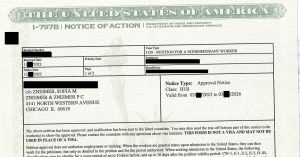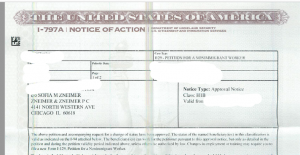The H-1B visa is a type of non-immigrant visa that allows U.S. employers to employ foreign workers in specialty occupations, such as in the fields of technology, engineering, and science. The H-1B status permits a foreign worker to live and work in the United States for up to six years, along with the worker’s spouse and children, unmarried and under 21, who receive H-4 status. Some H-1B workers who are in a process of applying for permanent residence can remain in the U.S. beyond the six-year maximum. Because immigrant visas are subject to per-country quotas, workers born in oversubscribed countries like India or China may take years, sometimes decades to receive permanent residence. Our Chicago immigration lawyers like to point out that under current backlogs, a physician born in India will wait over 11 years in line to receive a green card. In comparison, persons born in countries without backlogs, can immigrate as soon as the paperwork goes through, even if they are not in a professional or a specialty occupation.
If an H-1B worker is laid off, they will generally have to either find a new job and have their H-1B visa transferred to the new employer, or leave the United States. If the H-1B worker is waiting for a green card and is in a backlogged country, the new employer will have to restart the green card from scratch, but the worker’s place in line will not change because the new petition will receive the earliest filing date from any prior petition. If the worker is unable to find a new job and their H-1B visa is not transferred to a new employer, they will be out of status and may be subject to deportation. When a worker falls out of status for more than 180 days, they lose their ability to receive a green card even if they are close to receiving their green card in the line. It’s important for H-1B workers who have been laid off to talk with an immigration attorney to understand their options and ensure that they are in compliance with U.S. immigration laws.
If an H-1B worker is laid off, they may be eligible for a 60-day grace period during which they can remain in the United States and look for a new job. This grace period is known as “60-day portability” and it applies to H-1B workers who have been previously granted H-1B status and who have a new, non-frivolous H-1B petition filed on their behalf within 60 days of their previous H-1B employment ending. This provision Continue reading →





